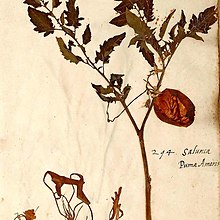
The House of Habsburg, also known as the House of Austria, is one of the most prominent and important dynasties in European history.
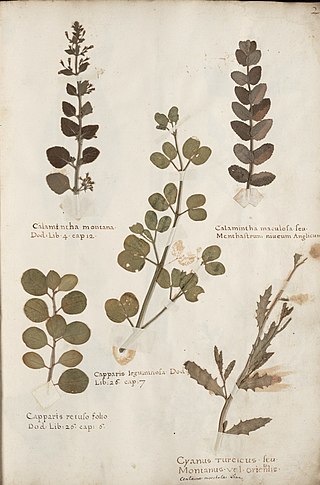
A herbarium is a collection of preserved plant specimens and associated data used for scientific study.

Leontopodium nivale, commonly called edelweiss, is a mountain flower belonging to the daisy or sunflower family Asteraceae. The plant prefers rocky limestone places at about 1,800–3,400 metres (5,900–11,200 ft) altitude. It is non-toxic and has been used in traditional medicine as a remedy against abdominal and respiratory diseases. Its leaves and flowers are covered with dense hairs, which appear to protect the plant from cold, aridity, and ultraviolet radiation. It is a scarce, short-lived flower found in remote mountain areas and has been used as a symbol for alpinism, for rugged beauty and purity associated with the Alps and Carpathians. It is a national symbol of several countries, specifically Bulgaria, Austria, Slovenia, Switzerland, and Italy. In Romania it was declared a "monument of nature" in 1931. The Edelweiss day is celebrated on 5 March. According to folk tradition, giving this flower to a loved one is a promise of dedication.
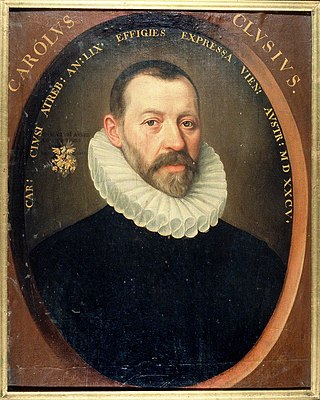
Charles de l'Écluse,L'Escluse, or Carolus Clusius, seigneur de Watènes, was an Artois doctor and pioneering botanist, perhaps the most influential of all 16th-century scientific horticulturists.

Andrea Cesalpino was a Florentine physician, philosopher and botanist.

Antonio José Cavanilles was a leading Spanish taxonomic botanist, artist and one of the most important figures in the 18th century period of Enlightenment in Spain.

Ulmus crassifoliaNutt., the Texas cedar elm or simply cedar elm, is a deciduous tree native to south-central North America, mainly in southern and eastern Texas, southern Oklahoma, Arkansas, and Louisiana, with small populations in western Mississippi, southwest Tennessee, and north-central Florida; it also occurs in northeastern Mexico. It is the most common elm tree in Texas. The tree typically grows well in flat valley bottom areas referred to as cedar elm flats. Its Latin name refers to its comparatively thick (crassifoliate) leaves; the common name cedar elm is derived from the trees' association with juniper trees, locally known as cedars.

The Bogor Botanical Gardens is a botanical garden located in Bogor, Indonesia, 60 km south of central Jakarta. It is currently operated by the National Research and Innovation Agency. The garden is located in the city center and adjoin the presidential palace compound of Istana Bogor. It covers an area of 87 hectares and contains 13,983 different kinds of trees and plants of various origin. The geographic position of Bogor means it rains almost daily, even in the dry season. This makes the garden an advantageous location for the cultivation of tropical plants.
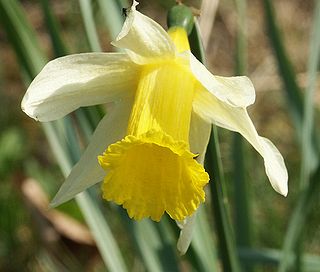
Narcissus pseudonarcissus, commonly named the wild daffodil or Lent lily, is a perennial flowering plant.

Banksia paludosa, commonly known as the marsh or swamp banksia, is a species of shrub in the plant genus Banksia. It is native to New South Wales, Australia, where it is found between Sydney and Batemans Bay, with an isolated population further south around Eden. There are two recognised subspecies, the nominate of which is a spreading shrub to 1.5 m (4.9 ft) in height, and subsp. astrolux is a taller shrub to 5 m (16 ft) high found only in Nattai National Park.
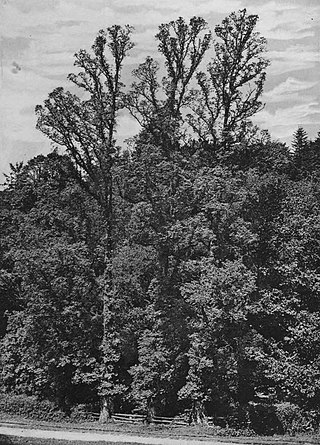
The field elm cultivar Ulmus minor 'Stricta', known as Cornish elm, was commonly found in South West England, Brittany, and south-west Ireland, until the arrival of Dutch elm disease in the late 1960s. The origin of Cornish elm in the south-west of Britain remains a matter of contention. It is commonly assumed to have been introduced from Brittany. It is also considered possible that the tree may have survived the ice ages on lands to the south of Cornwall long since lost to the sea. Henry thought it "probably native in the south of Ireland". Dr Max Coleman of Royal Botanic Garden Edinburgh, arguing in his 2002 paper on British elms that there was no clear distinction between species and subspecies, suggested that known or suspected clones of Ulmus minor, once cultivated and named, should be treated as cultivars, preferred the designation U. minor 'Stricta' to Ulmus minor var. stricta. The DNA of 'Stricta' has been investigated and the cultivar is now known to be a clone.
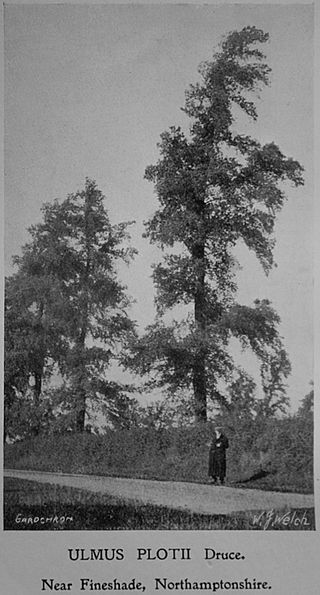
The field elm cultivar Ulmus minor 'Plotii', commonly known as Lock elm or Lock's elm, Plot's elm or Plot elm, and first classified as Ulmus sativaMill. var. Lockii and later as Ulmus plotii by Druce in 1907-11, is endemic mainly to the East Midlands of England, notably around the River Witham in Lincolnshire, in the Trent Valley around Newark-on-Trent, and around the village of Laxton, Northamptonshire. Ronald Melville suggested that the tree's distribution may be related to river valley systems, in particular those of the Trent, Witham, Welland, and Nene. Two further populations existed in Gloucestershire. It has been described as Britain's rarest native elm, and recorded by The Wildlife Trust as a nationally scarce species.

The elm cultivar Ulmus 'Crispa' [:'curled', the leaf margin], sometimes known as the Fernleaf Elm, arose before 1800 and was first listed by Willdenow as U. crispa (1809). Audibert listed an U. campestrisLinn. 'Crispa', orme à feuilles crépues [:'frizzy-leaved elm'], in 1817, and an Ulmus urticaefolia [:'nettle-leaved elm'] in 1832; the latter is usually taken to be a synonym. Loudon considered the tree a variety of U. montana (1838). In the 19th century, Ulmus × hollandica cultivars, as well as those of Wych Elm, were often grouped under Ulmus montana. Elwes and Henry (1913) listed 'Crispa' as a form of wych elm, but made no mention of the non-wych samara.
The hybrid elm cultivar Ulmus × hollandica 'Tricolor' was first listed as U. suberosa tricolor by C. de Vos in 1867.

The Duchy of Styria was a duchy located in modern-day southern Austria and northern Slovenia. It was a part of the Holy Roman Empire until its dissolution in 1806 and a Cisleithanian crown land of Austria-Hungary until its dissolution in 1918.

The Orto Botanico dell'Università di Pavia also known as the Orto Botanico di Pavia, is a botanical garden maintained by the University of Pavia. It is located at Via S. Epifanio, 14, Pavia, Italy, and is open to the public on weekends. The botanical garden covers an area of about two hectares and has approximately two thousand different species of plants, which are organised in sections. The current director is Francesco Sartori.The Botanical Garden stands in the place where the church of Saint Epiphanius was located, of which it preserves the cloister of the 15th century.

Ulmus parvifolia, commonly known as the Chinese elm or lacebark elm, is a species native to eastern Asia, including China, India, Japan, Korea, and Vietnam. It has been described as "one of the most splendid elms, having the poise of a graceful Nothofagus".
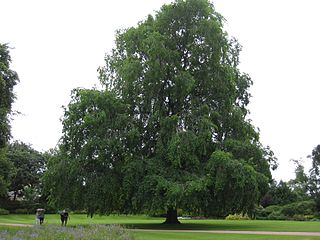
Ulmus × hollandica 'Wentworthii Pendula', commonly known as the Wentworth Elm or Wentworth Weeping Elm, is a cultivar with a distinctive weeping habit that appears to have been introduced to cultivation towards the end of the 19th century. The tree is not mentioned in either Elwes and Henry's or Bean's classic works on British trees. The earliest known references are Dutch and German, the first by de Vos in Handboek tot de praktische kennis der voornaamste boomen (1890). At about the same time, the tree was offered for sale by the Späth nursery of Berlin as Ulmus Wentworthi pendulaHort.. The 'Hort.' in Späth's 1890 catalogue, without his customary label "new", confirms that the tree was by then in nurseries as a horticultural elm. De Vos, writing in 1889, states that the Supplement to Volume 1 includes entries announced since the main volume in 1887, putting the date of introduction between 1887 and 1889.
The conservation and restoration of herbaria includes the preventive care, repair, and restoration of herbarium specimens. Collections of dried plant specimens are collected from their native habitats, identified by experts, pressed, and mounted onto archival paper. Care is taken to make sure major morphological characteristics are visible. Herbaria documentation provides a record of botanical diversity.
David van Royen was a Dutch physician and botanist who worked at the Leiden Botanical Gardens where he succeeded his uncle Adriaan van Royen (1704-1779) as director.
